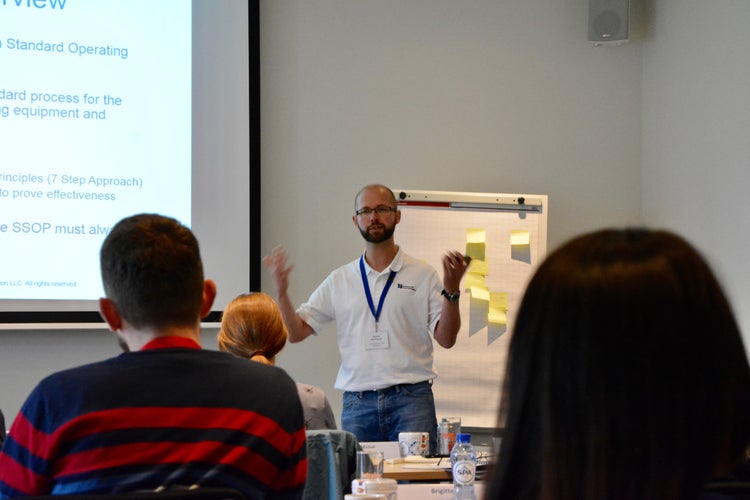The Importance of Crisis Preparation

No one wants to think about crisis management but for companies in the food industry, preparing for crises is just as important as planning for operational and capital expenditures. High volumes, increased speed, new equipment, slim margins, foreign materials, mislabeling, allergens and pathogens mean the inevitability of a crisis grows exponentially every year.
Successfully emerging from a crisis entails diligence, planning and practice. The North American Meat Institute (NAMI) encourages its members to start the crisis planning process long before any crisis emerges. NAMI suggests anticipating a range of potential scenarios by assessing unique vulnerabilities and building a plan around the findings.
“While problems and challenges are inevitable for processors, the chances that they will become a full-blown crisis are much lower if good planning occurs beforehand,” says Matt Raymond, public affairs, NAMI, Washington, D.C. “If they find themselves in a crisis without having laid their communications and response groundwork, the damage to their business, if not also to consumers, public health or the environment could be serious and long-lasting.”
Food defense
“This is not easy to do, which is why some companies feel a crisis is inevitable. It doesn’t have to be inevitable if you build a company culture focused on food safety and continuous improvement.”
Anticipating a crisis can feel like building a defense against the unknown. To avoid a food safety-related crisis, Commercial Food Sanitation (CFS), New Orleans, recommends plant operators institute highly evolved and highly functional food safety controls and a strong culture of continuous improvement.
“This is not easy to do, which is why some companies feel a crisis is inevitable,” says Dan Schmitz, operations director, CFS, an Intralox company. “It doesn’t have to be inevitable if you build a company culture focused on food safety and continuous improvement.”
This includes sanitation and safety programs, good agricultural practices, good manufacturing practices (GMPs), environmental monitoring, periodic cleaning and controls for foreign materials, labeling and allergens. Schmitz recommends ensuring these programs are the best they can be because slippage in these programs can lead to a failure and a crisis.
Smithfield Foods Inc., Smithfield, Virginia, believes in taking a proactive stance on food safety and quality and workplace safety. The company partners with industry, government and independent experts to create and implement leading, science-based food safety and quality practices. Smithfield practices a zero-tolerance policy regarding food-safety violations and “places responsibility for food safety squarely on the shoulders of every employee,” according to Lisa Martin, senior communications manager with Smithfield. The company’s Raise Your Hand initiative encourages employees to speak up if they see something concerning.
With so much to keep an eye on, it’s critical any crisis management plan includes the entire organization. Keeping staff informed of potential crisis scenarios and demonstrating how the company plans to handle a crisis creates a cohesive approach and better prepares all involved.
CFS recommends training and practice in the form of evacuation drills, mock recalls, traceability exercises, site lockdowns and simulated medical emergencies.
“Employees are often included as an audience in crisis response plans, but they are rarely thought of as partners in the crisis response,” says Kim Essex, managing director at Ketchum, a global public relations agency with specialization in meat and poultry communication and marketing, food safety, animal welfare and crisis preparedness. “What’s needed most is clarity of roles. Letting everyone know what will happen in a crisis, how they will be engaged and what their role will be. Most employees are very empathetic to their company in times of crises and want to know what they can do to help. They are a tremendous asset.”
CFS recommends training and practice in the form of evacuation drills, mock recalls, traceability exercises, site lockdowns and simulated medical emergencies. Ketchum adds an additional suggestion of asking colleagues in each part of the business what could go wrong and what issues keep them up at night, looking at all crisis scenarios through an outsider’s lens to ask how these issues would appear to someone outside of the business.
“What may seem routine to you will not feel that way to your customers and stakeholders,” says Bill Zucker, managing director, Ketchum. “The Food Safety Modernization Act and the power of social media have made it more and more likely that the details of your recall or other incidents will become public so ask yourself how this will look under the microscope of transparency.”
In some cases, judgment may be occurring in areas that have not yet come to the attention of the processor as is in the case of Salmonella outbreaks. Food industry attorney Shawn Stevens, Food Industry Counsel (FIC), Milwaukee, cautioned that declining vigilance for proper handling of meat and poultry products leaves food processors increasingly vulnerable.
“Salmonella was never thought of as something that could create a crisis,” Stevens says. “Yet, this is something all processors need to pay attention to. It’s likely always happening but until recently it’s not been illuminated.”
The Centers for Disease Control (CDC) estimates Salmonella is responsible for 1.2 million illnesses, 23,000 hospitalizations and 450 deaths in the US every year with food being the culprit in about 1 million of these illnesses. Over the last two decades, CDC has tracked the DNA fingerprints of bacteria from patients through PulseNet. The network pinpoints where outbreaks occur, identifies the source, alerts the public and highlights any food safety gaps. This information identifies clusters of disease that could represent unrecognized outbreaks. Since the late 1990s, 1 million isolates have been uploaded to the system and many of the cases remain unsolved, according to Stevens.
Rising outbreaks of multidrug-resistant bacteria continue to change how USDA/FDA is tackling outbreak analysis. Whole-genome sequencing (WGS) is improving understanding of pathogen transmission via genotyping methods. As WGS becomes more accessible and affordable, USDA/FDA can verify if a pathogen matches the information in PulseNet. The ability to compare against human isolates could speed identification and analysis, according to Stevens.
In anticipation of a crisis, he recommends processors reassess current contracts with all suppliers to verify they’re protected if they receive contaminated product that’s not considered adulterated by USDA. In addition to revising contracts for emerging exposure, he advises purchasing recall insurance, reviewing the policy to understand exactly what it covers and having an adequate and active crisis management plan.
“Part of good crisis planning is to determine which issues could become a crisis and where it’s possible to change practices to eliminate the risk,” Zucker says. “Some crises are inevitable, but many more only become a crisis because a company doesn’t recognize that in handling an issue it’s not meeting the expectations of its stakeholders. A good crisis plan guides you to the right questions and actions before it gets to crisis stage.”
Run the drill
“Whenever possible, get ahead of issues so accurate, timely information gets out and detractors and critics aren’t the ones who define you or dictate terms,” says NAMI’s Raymond. “There are thousands of possible crises and unexpected events, some anticipated and others not, that can generate a lack of trust, or in a worst-case scenario, cause a processor to close its operation.”
CFS recommends having monitoring systems in place to ensure programs are working as intended and creating a cross-functional team to create the emergency crisis plan. Also establish and maintain a range of communications channels including social media, customer service and media lists and prepare messages and resources like fact sheets, visuals or “dark” websites in advance.
According to NAMI, a company’s ability to survive a crisis depends on anticipating and preparing for a potential crisis. FIC recommends testing all plans with a mock crisis at least annually. For recall situations, this includes a scenario for the processor to work through incorporating real-world elements of illnesses reported, likely production dates and other pertinent facts on a compressed timeline. This enables processors to test their current plan, refine processes and find gaps and efficiencies.
“I find most processors think about crises in terms of public-facing incidents that can erode confidence if not addressed swiftly and responsibly,” Essex says. “They’re less prepared for customer demands that can impact operations as much, if not more, than these classic crisis moments.”
Looking forward
Companies ready to pivot and correct can strengthen their brand and consumer loyalty and those who do not, risk becoming a cautionary tale. Essex recommends working with associations, including borrowing draft plans and attending workshops and networking forums. These associations can recommend firms with relevant experience and advise companies in times of crises. Stevens stresses when looking for assistance, always choose organizations with extensive experience in the meat and poultry industries. Those who lack experience and knowledge of the industry can cause more damage.
“As technology improves and regulatory environments evolve, so must the processing plant food safety programs,” Schmitz concludes. “A facility culture of ‘we have always done it this way’ means the culture of the facility is already behind and the risk of a crisis is increasing every day. The facility culture should be built around continuous improvement and keep up with the ever-changing world.”



